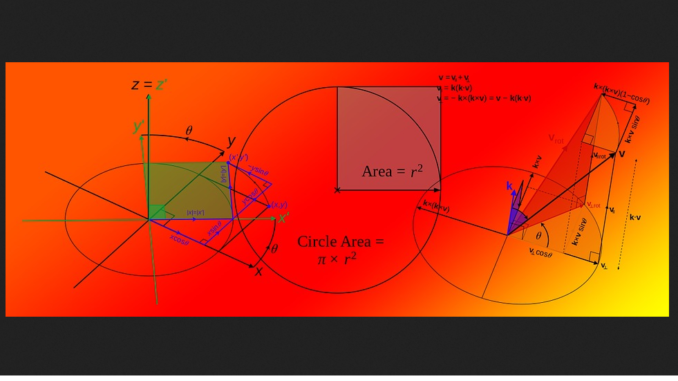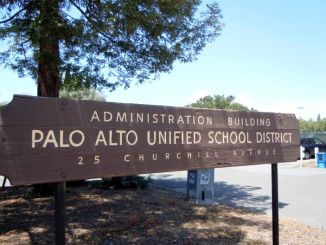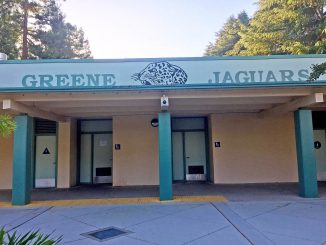
By Braden Cartwright
Daily Post Staff Writer
A lawsuit challenging the Palo Alto Unified School District’s practices for placing ninth graders in math classes has sparked a debate about how fast students should be allowed to advance, and what that does to their mental health.
On one side, there’s a group who thinks the district should be more focused on mental health and helping students who are struggling than students who are bored.
The other side wants the opportunity for students to advance through math quicker, so they can be challenged in their classes.
Four parents in favor of advancement sued the district and won, with Judge Carrie Zepeda ruling on Feb. 6 that the district violated the state’s Mathematics Placement Act of 2015.
Zepeda ordered the district to come back with a policy that allows students to skip to the next level of math by doing well on a test in the first month of ninth grade.
The new policy must allow students who take college-approved courses outside of the district to skip classes in high school, Zepeda said.
The judge will hold a compliance hearing scheduled for April 4.
The usual progression of math classes in Palo Alto goes from Algebra 1 to Geometry to Algebra 2.
Students take tests in middle school that determine when they start Algebra 1, with the default being eighth grade. The most advanced students start in seventh grade, while some students don’t start Algebra 1 until their freshman year.
The usual pathway puts students a year beyond what the state recommends, Superintendent Don Austin said.
A student’s placement in middle school can determine what class they reach in their junior and se-nior year. After Algebra 2, they can take Statistics, Intro to Data Science, Precalculus or Analysis, and then AP Calculus and community college courses become available.
Daniel Pan, a student representative on the school board, said at a meeting on March 14 that math has caused him “tremendous stress.”
Pan said he was separated from the rest of his peers in eighth grade because he thought he could succeed, and geometry in ninth grade was “very, very challenging.”
“Ever since ninth grade, I wake up every day not wanting to go to school because of math, because of how much stress it brings me,” he said.
Pan said parents see math as a “pathway to imaginary success in life” for their children.
“Please, parents, rethink what success means to you and your children. It shouldn’t mean beating other people’s children,” Pan said.
Austin posted a clip of Pan’s comments on the district’s YouTube page and his personal Twitter count.
“Proud of our rep for speaking truth! #Brave,” Austin said.
New board member Shana Segal spoke in favor of allowing students to accelerate.
As a teacher, Segal said she has watched students struggle when they aren’t challenged.
Segal took issue with people who say that parents who want their kids in a higher level class should go to private school, because private school is too expensive for most families.
The parents who want to accelerate are just trying to improve the lives of their kids, Segal said.
Segal was the only board member to speak at the meeting, as the report on math enrollment was on the agenda for information only. The board also hasn’t publicly talked about the lawsuit.
Shounak Dharap indicated at a City-School Liaison Committee meeting on March 16 that the rest of the board is not aligned with Segal. He said they are focused on equity and mental health over acceleration.
“The board has expressed an ironclad priority for equity and mental health Especially considering we are the number one district, and we are doing very well by all measures in terms of our ceiling. So the floor is where the board has dedicated its priority.”
The district has already taken some steps to comply with the Mathematics Placement Act, including publishing data showing the gender and race of students in ninth grade, along with the math class they are in.
The data shows that Latino students are more likely to be in a lower level math class, and Asian students are more likely to be in an advanced class.
There are 82 students in Algebra 2, on the most advanced pathway. Nine of them white, five are more than one race, one is Latino and 67 are Asian.
Another 15 students are even more advanced, in classes that are usually reserved for juniors. Two of these students are white, and 13 are Asian.
There are 704 ninth graders taking Geometry, the default level, and 249 taking Algebra 1, the minimum level.
The data shows that two-thirds of Latinos in ninth grade and 14 of 19 black students are in Algebra 1.




Holding back intelligent students so that the others can catch up makes no sense at all. It’s like socialism — take from the people who work hard and give it to the lazy.
What you’ve described is capitalism, a welfare state for billionaires. Socialism is when you give the people who work hard (workers) the fruits of their labor – housing, healthcare, food.
Yeah, like Venezuela
No I think you’re confused. What you’re describing is actually capitalism, where the lazy rich steal from the workers.
I do not understand why Daniel Pan chose to sit in an accelerated math class and attributed his struggle and stress to his peer classmates. If Daniel was forced to be there by his parents, then let’s come up with a solution to prevent parents from forcing students taking advanced math classes. You cannot punish students who are genuinely interested in math for others’ fault.
Misapplication of “Growth Mindset” (Dweck) is all the rage: patting students on the head for toiling away at schoolwork, on the hope that working longer is expenditure of effort that will make up for lack of so-called “fixed” talent/ability. Worthiness and effectiveness of practice is not questioned.
Thank you Tom and THANK YOU Shana Segal. If the leadership is focused on solutions for anyone they should communicate those details as it is not obvious they understand the floor nor the ceiling.
For the sake of equity our district leadership wants to give anyone the chance to take any class–regardless of performance in prior classes. Sometimes this is a good thing when a student is borderline. But if a student lacks solid preparation for it–and doesn’t take advantage of teachers nor the free on-campus and online free tutoring–the likelihood of proficiency is low and of having excessive stress is high. Ironically, they seem to think this situation is good for low-achieving students but bad for high-achieving ones? The district continues to generalize to the point of seeming biased against high achieving students/families. Eg, Dharap implies equity and [good] mental health cannot co-exist with acceleration. Bizarre.
To your point about discouraging parents from forcing their students:
– We could have “signposts for success” at the progress report prior to the end of semester 1; shift the burden onto the parents for the consequences.
– We could be publishing the# students who drop down at Semester from the H math lanes (there are a sizable number) to let parents know it can disrupt an otherwise great schedule (sometimes other classes have to change to accommodate the drop).
– We could have placement exams to inform (not necessarily to deny) placement
– We could continue to educate at parent events about how excessive stress interferes with learning/retention, including parent sharing (within ethnic groups if seems beneficial)
– We could bring in the data about poor mental health when students feel trapped by their parents’ ambitions; perhaps hold some counseling sessions for the parents/students on this topic
These things could shift the culture in a positive way, requiring less attention as they become norms. In some ways the district’s “non-leadership” approach promotes failure on both ends.
I was deeply touched by the video and it showcases how severe the situation is and how crucial our school district should take right actions towards. Our public elementary and middle schools may have failed to well prepare students for the high school and future STEM education, which is highly possibly the root cause of why students feel so struggled when challenged with real math in high school. This is especially true considering current ninth graders were using the highly controversial and simplified math curriculum (everyday math and big idea math) in their elementary and middle school time. In the meantime, private middle/elementary schools where wealthy families sending their kids are typically 1-2years ahead of common core in early grades with much deeper and more solid education and their students could face much less an issue when being challenged with high school math. These are indeed hypotheses while PAUSD could easily have data to prove this. PAUSD could take actions to provide statistics upon the students performance and stressfulness on math by subgrouping on where the students are receiving their education before high school, and learn from the experience to seriously better prepare students for STEM in elementary and middle school time.
Note that I strongly thinks that school district should put more resources to help raise the floor by revisiting the current teaching strategy. My friend’s 5th-grader who transferred from San Carlos public school to here and find every class here is simpler than their district. In the meantime, the ceiling should always remain open instead forced closure, which requires much less resources and may help improve raising the floor as well.
Moreover, it’s very concerning that the school district seems standing aside with the student who sees math as a way to differentiate student just like kinds of sports. Math is the foundation of STEM and crucial for the future of our nation and our civilization. The difference among the college admission could be less and less meaningful in the future while the strength of math foundation matters life-long!
(Even for sports, it’s so normal that different players grow in different paces. Why seeing a younger peer performing better causing pressure? It’s toxic! And it’s even more toxic that it seems that all the board except Segal can’t see this issue. I’m working with peers 10 years younger than me with higher positions and I feel so glad that I could work with so smarter guys directly!)
“why students feel so struggled” … that’s an interesting variation of the word “struggle” … guess we’re not talking about Advanced Placement English.
Play nice! You picked out one error in an otherwise sincere and thoughtful commentary. And if you are interested in proper grammar you didn’t capitalize nor use ellipses properly. 🙂
The parent in qs obviously has English as a second language, but got his/her point across eloquently. Your snide remark reflects on you.
The smart kids must be allowed to learn at their own pace. They cannot be held back by their peers. Help is available. Students are taught to memorize formulas but not about real-world applications. Math doesn’t have to be boring.
To the extent possible, all the students should have the opportunity to learn at a pace most suited to them at a particular time. Using all kinds of in-person and online methods. Because math ability differs wildly by person and time; if it is either too easy or too difficult for an individual, they will not learn how to learn the next steps.
Elevate the bar; help EVERYONE reach a high goal. Push up the floor instead of pulling down the ceiling.
Hire more tutors, teacher assistants and one on one help for the struggling students – PAUSD has the money!
Let’s not move our society from “no one left behind” to “no one gets ahead”.
We’re trotting our colts before they’re big enough and breaking their legs
Where trotting our colts before they’re ready and breaking their legs. It’s the Stanford way.
“If everyone is Special, then no one is.” -The Incredibles
When the world comes to Palo Alto looking for the best and brightest at math finally they’ll realize all our kids are average and we will have commoditization all our workers, I mean proletariat means of production. Now we just need another court order for Stanford, Berkeley, and USC ordering them to start accepting average students.
I was struggling badly at math until I was accelerated, at which point school became less stressful. Being bored can be dangerously stressful as well. And, my career path into my early 30s can be directly traced to the consequences of having taken math classes through UC Extension while in high school.
Mine is an unusual story, but the Bay Area has a concentration of such unusual stories. Our children are more normally distributed than their parents, and it’s hard for us as parents to accept that fact… It’s especially difficult for parents who had to hustle hard to get here. Their children’s ability to handle stress is more normally distributed than their own as well.
What is needed is both the option of advanced math classes but also guidance not just for the kids but for their parents. This community can afford it. Raise the money and pay for counselors who are better trained than the usual college placement counselor.
If equity is the main objective in public education, then shouldn’t the varsity teams adhere to the same principle by not allowing any sophomores or juniors and requiring all seniors to play, rotating through every position without regard to race, religion, or ability?
Shounak Dharap and the pro low achievement board is expressing a false choice. There is no reason to stop capable and motivated students from advancing in their own lane while simultaneously protecting the mental health of others who want an easier curriculum. They speak of diversity of choice but they don’t really mean it.
Thank you Shauna for the bravery to speak the truth and for standing up for all students, including Asian ones, who, even in this day and age, the district appear to think of as the model minority. Getting rid of math acceleration is racist and backwards- how are our kids going to compete in a global economy when they’re adults, when they don’t even have a solid foundation in math?? What about all those STEM careers? What about the fact that getting rid of math acceleration disproportionally affects the Asian POC kids? The district put out a math survey recently, and surprise! Most kids don’t have tutors, and most kids think math is important and want to take accelerated math to pursue STEM careers. I don’t see why the district can’t just provide free tutoring to the kids who need it. Raise the bar by providing support, not by limiting achievement. Don’t do it by racial math redlining. Because that is exactly what this is, here in this “progressive” town of hypocrisy.
I agree so much :tears.
They did the same thing in Virginia, and I think they successfully stopped some students from reaching their dreams. Bait and switch.
This actually happened to me in junior high school. The principal said that the rest of the class was not ready for algebra, so I got behind a year. It was BS, and as I look back, she was trying to stop the advancement of the immigrant kids.
Kids all over the world, even my home third world country are about TWO YEARS ahead of US public schools. Also, why aren’t they doing this in public schools in the Midwest?
I am sick of the stereotyping… Some Asian kids want to be singers or athletes. Some Mexican kids want to be engineers. They need to be allowed to learn at least what kids all around the world are so they can have choices.
#SchoolChoice.
#SchoolChoice. Parents get to choose where their kids go to school.
Just pipe down and take your Soma